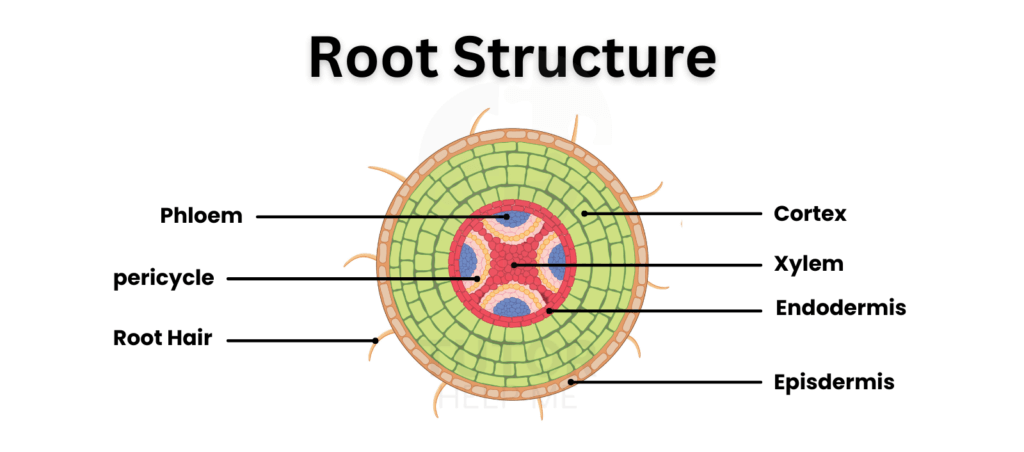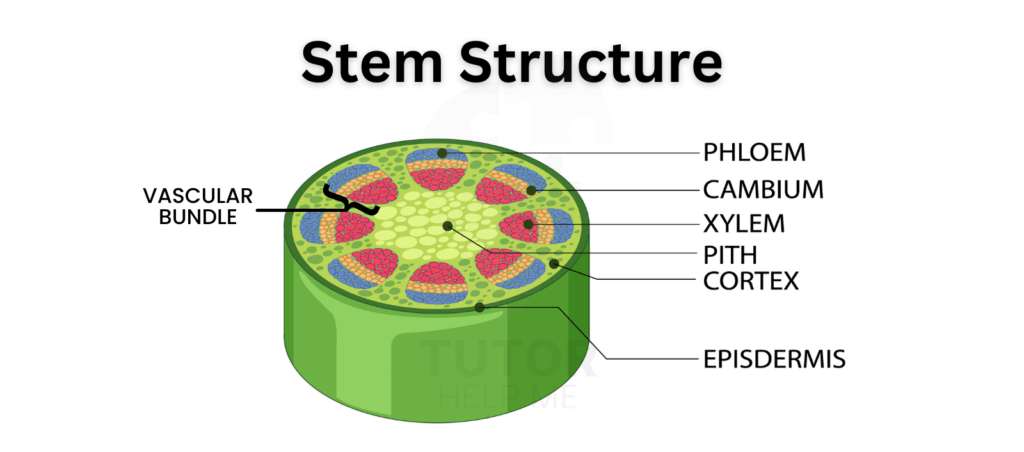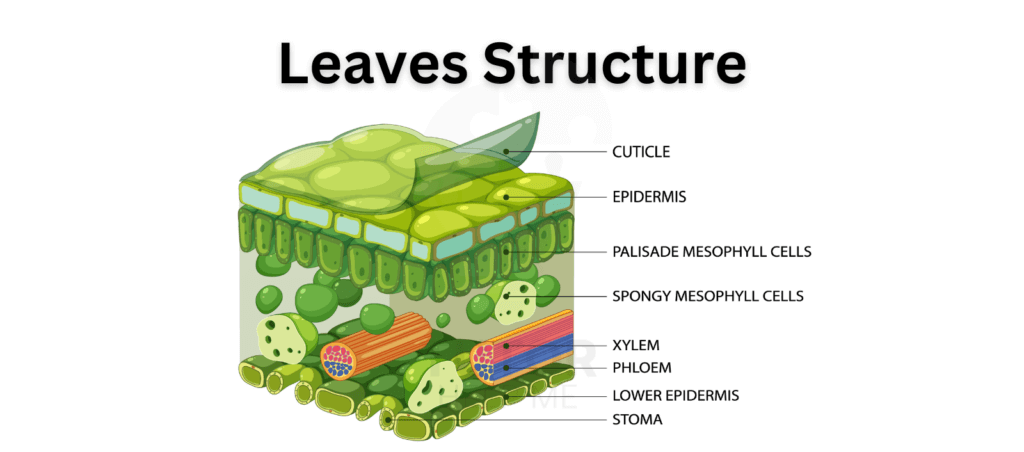Plant anatomy is the study of the internal structure of plants. It focuses on how different plant organs, such as roots, stems, and leaves, are made up of various cell types and tissues that work together to keep plants alive.
In vascular plants, specialised tissues transport water and nutrients. These include xylem and phloem, which form the vascular bundles responsible for moving essential substances throughout the plant body.
The study of basic plant anatomy is essential for understanding how plants take up water and nutrients, store food, and support their structure.
Why Is Understanding Plant Structure Important?
Learning about plant anatomy is important for many reasons:
✔ Understanding Growth: Different plant parts, including meristem tissues, allow plants to grow and repair themselves.
✔ Improving Agriculture: Farmers and scientists use knowledge of vascular plants to enhance crop growth and food production.
✔ Medical & Environmental Benefits: Many plant species contain medicinal compounds, and knowing their structure helps in conservation and drug development.
✔ Adapting to the Environment: Different plant species have evolved specific adaptations, such as fibrous roots for better water absorption or modified stems for food storage.
Plant anatomy is crucial in various fields, from botany to agriculture, and helps explain how plants survive in different environments.
Root Structure and Function
Roots are underground structures that take up water and nutrients needed for growth. They form a part of the plant body and work with stems and leaves to keep the plant alive.
Roots are made of vascular tissue, including xylem and phloem, which transport water and food to the rest of the plant. These structures allow plants to survive in different environments, from aquatic plants to those growing in tropical regions.
What Are the Main Functions of Roots?
Roots perform several vital functions:
1️⃣ Absorbing Water and Minerals: Roots take up water and nutrients from the soil through root hairs and vascular bundles.
2️⃣ Anchoring the Plant: Roots anchor the plant in the soil, providing structural support, especially for large trees like banyans.
3️⃣ Storing Food: Some roots are modified for food storage, such as carrots and sweet potatoes.
4️⃣ Providing Additional Support: Special roots, like prop roots in mangroves, help plants survive in unstable conditions.
5️⃣ Interacting with Microorganisms: Roots form relationships with fungi and bacteria to help in nutrient absorption.
What Are the Different Types of Roots? (Taproots vs Fibrous Roots)
Roots are classified based on their structure and function.
Taproots
- Found in dicot plants like carrots and radishes.
- Consist of a single large root with lateral roots branching out.
- Help in deep water absorption and food storage.
Fibrous Roots
- Common in monocots like wheat and rice.
- Have a network of thin, branching roots.
- Provide a large surface area for absorbing nutrients.
Both root systems help plants take up water and nutrients while providing stability.

How Do Roots Absorb Water and Nutrients?
Roots use specialised structures to absorb water and minerals efficiently.
✔ Root Hairs: Increase surface area for better absorption.
✔ Endodermis: Regulates water and mineral intake.
✔ Pericycle: Produces lateral roots for expansion.
✔ Xylem and Phloem: Caries water to the shoot system and distributes nutrients.
Roots also absorb oxygen, which is essential for cellular respiration in plant organs.
What Is the Role of Root Hairs?
Root hairs are tiny extensions that:
- Increase the surface area of roots.
- Help absorb more water and minerals.
- Prevent excessive water loss by regulating intake.
Without root hairs, plants would struggle to take up water and nutrients, leading to poor growth.
How Do Root Modifications Help Plants Survive? (Storage Roots, Aerial Roots)
Some roots are modified to adapt to specific environments.
🌱 Storage Roots:
- Modified for food storage in plants like carrots and beets.
- Store starch and sugars to support growth.
🌿 Aerial Roots:
- Found in epiphytic plants that grow aboveground.
- Absorb moisture from the air instead of soil.
🌊 Prop Roots:
- Found in mangroves and banyans, helping plants stay upright in unstable environments.
Stem Structure and Function
The stem is an essential part of a plant’s shoot system, supporting other plant organs like leaves, flowers, and fruits. It plays a crucial role in transport, storage, and growth, ensuring the plant body remains strong and functional. Different plant species have unique stem adaptations that help them survive in various environments.
What Is the Function of a Stem in a Plant?
The stem serves multiple functions that are vital for plant growth and survival:
- Support and Structure: The stem holds leaves, branches, and flowers in position, maximising surface area for photosynthesis.
- Transport of Water and Nutrients: The vascular system, made of xylem and phloem, carries water and minerals from the roots to the rest of the plant.
- Storage of Food and Water: Some modified stems store food for the plant, helping it survive in harsh conditions.
- Growth and Development: The meristem in the stem allows continuous growth by producing new cells.
What Are the Different Types of Stems?
There are two main types of plant stems based on structure and composition:
1. Herbaceous Stems
- Found in vascular plants like grasses and flowers.
- Soft, green, and flexible.
- Do not develop vascular bundles of wood.
2. Woody Stems
- Found in trees and shrubs.
- Hard, brown, and rigid.
- Contain vascular bundles that provide structural support.
Both types of stems help different plant species thrive in their respective environments.
How Does the Stem Support the Plant?
The stem provides structural support by holding different parts of the plant, such as branches, leaves, and flowers, in position. It consists of nodes and internodes, where buds develop into new shoots. Some stems and leaves work together to maximise photosynthesis by adjusting their angle towards sunlight.
The stem also contains ground tissue, including parenchyma cells, which provide strength while maintaining flexibility. In some vascular plants, sclerenchyma cells add extra durability to withstand wind and environmental stress.
What Is the Role of Xylem and Phloem in Transport?
The vascular system in the stem consists of two key components:
- Xylem: Carries water and minerals from roots to stems and leaves. It also provides structural support.
- Phloem: Transports nutrients from the soil and sugars from photosynthesis to all plant parts.
These vascular bundles ensure the efficient movement of water and nutrients, maintaining plant health.

How Do Stems Store Food and Water?
Certain plant stems are modified for food storage, helping plants survive extreme conditions.
- Tubers (e.g., potatoes) store starch, acting as an energy reserve.
- Rhizomes (e.g., ginger) grow underground and store nutrients for new growth.
- Stolons (e.g., strawberries) allow plants to spread by producing new buds along their length.
In aquatic plants, stems help store water and minerals, ensuring survival in flooded environments.
What Are Some Stem Modifications?
Some stems adapt to specific environments by changing their structure:
- Tendrils: Thin, coiled modified stems that help climbing plants attach to surfaces.
- Thorns: Hard, pointed branches that protect plants from herbivores.
- Aerial Roots: Found in plants like the banyan, providing additional support.
- Prop Roots: Support tall plants by anchoring them into the ground.
Leaf Structure and Function
Leaves are essential plant organs responsible for producing food for the plant through photosynthesis. They also play a key role in gas exchange, transpiration, and storage. Although leaves come in various shapes and sizes, their structure is adapted to maximise their function in vascular plants.
What Is the Function of Leaves in Plants?
Leaves serve multiple purposes, including:
- Photosynthesis: Leaves absorb sunlight and convert it into energy, providing nourishment for the plant body.
- Gas Exchange: The lower epidermis of the leaf contains stomata, allowing carbon dioxide in and oxygen out.
- Transpiration: Water evaporates through stomata, creating a pull that helps vascular tissue transport water and minerals from the roots.
- Storage: Some leaves store food or water, supporting survival in harsh conditions.
These functions enable plants to grow, develop, and sustain life.
How Is a Leaf Structured?
Leaves contain several layers of cells, each playing a specific role:
Cuticle – A waxy coating on the adaxial (upper) and abaxial (lower) leaf surfaces that prevents water loss.
Upper Epidermis – A protective layer that allows sunlight to pass through to the inner cells.
Mesophyll – The main site of photosynthesis, divided into:
- Palisade Mesophyll – Contains parenchyma cells with chloroplasts, absorbing sunlight.
- Spongy Mesophyll – Features intercellular spaces that aid in gas exchange.
Vascular Bundles (Xylem and Phloem) – These vascular tissues transport water and nutrients.
Lower Epidermis – Contains stomata for gas exchange and transpiration.
The midrib runs through the centre of the leaf, providing structural support and ho using vascular bundles.

How Do Leaves Regulate Gas Exchange?
Leaves regulate gas exchange through stomata, which are small openings in the lower epidermis.
- Stomata open during the day, allowing carbon dioxide to enter for photosynthesis.
- Oxygen, a byproduct of photosynthesis, is released through stomata.
- Water vapour exits the leaf via transpiration, which helps draw water and minerals from the roots.
The opening and closing of stomata are controlled by guard cells, which respond to environmental conditions like humidity and light.
What Are the Different Types of Leaves?
Leaves are classified into two main types:
Simple Leaves – Have a single lamina (leaf blade).
Compound Leaves – Consist of multiple leaflets attached to a single petiole.
Different plant species have evolved leaf structures suited to their environments.
How Do Leaf Adaptations Help Plants Survive?
1. Needle-Like Leaves (e.g., Pine trees)
- Reduce surface area, minimising water loss.
- Adapted for cold and dry environments.
2. Waxy Coatings (e.g., Aquatic plants)
- Prevent excess water absorption.
- Protect leaves from damage due to excess moisture.
3. Leaf Modifications
- Tendrils (e.g., Peas) help climbing plants attach to surfaces.
- Spines (e.g., Cacti) protect against herbivores and reduce water loss.
These adaptations allow plants to thrive in various ecosystems.
How Do Roots, Stems, and Leaves Form a Transport System?
In vascular plants, the vascular system enables the movement of water, minerals, and food between different plant parts. This system consists of xylem and phloem, which transport substances throughout the plant body.
1. The Role of Roots
- Roots anchor the plant and absorb water and minerals from the soil.
- Root hairs increase the surface area for better absorption.
- The endodermis regulates the movement of water into the vascular tissue.
- Lateral roots extend from the main root to support plant stability.
2. The Function of Stems
- Stems and leaves form the shoot system, which transports nutrients.
- Vascular bundles in the stem contain xylem, which carries water from roots to leaves.
- Phloem parenchyma transports sugars produced during photosynthesis to the rest of the plant.
- Nodes and internodes provide structural support and allow new growth.
3. The Role of Leaves
- Leaves are specialised for photosynthesis, using mesophyll cells to convert sunlight into energy.
- Petiole connects the leaf to the stem, allowing transport of nutrients.
- Stomata on the lower epidermis regulate gas exchange, balancing carbon dioxide intake and oxygen release.
Together, these plant organs ensure efficient resource distribution within vascular plants.
How Do Plants Distribute Nutrients and Energy?
Plants require food for the plant to sustain growth and development. The vascular system plays a key role in nutrient distribution.
1. Transport via Xylem and Phloem
- Xylem moves water and minerals upwards from roots to leaves.
- Phloem carries sugar from leaves to plant parts for energy storage and use.
2. Storage and Support
- Stems store nutrients from the soil and provide structural support.
- Modified stems, such as rhizomes and stolons, allow plants that grow underground to spread.
3. Role of Leaves in Energy Production
- Leaves to the rest of the plant transport sugars for growth.
- Compound leaves and simple leaves vary in structure but perform the same function.
This efficient transport system allows plants to grow in diverse environments, from aquatic plants to land species.
How Do Environmental Factors Affect Plant Growth?
Several external factors influence how roots, stems, and leaves function together.
1. Light Availability
- Photosynthesis depends on sufficient sunlight for energy production.
- Mesophyll cells adjust their activity based on light intensity.
2. Water Supply
- Fibrous roots help plants take up water and nutrients in dry conditions.
- Aerial roots, found in epiphytic plants like the banyan, absorb moisture from the air.
3. Temperature and Climate
- Hot weather increases transpiration, affecting water levels.
- Cold conditions slow down nutrient movement through vascular bundles.
4. Soil Composition
- Nutrients from the soil impact plant growth and overall health.
- Sclerenchyma cells provide strength in vascular tissue, helping plants survive in harsh conditions.
By adapting to different environmental factors, plants maintain survival and reproduction in various ecosystems.
How Do Roots, Stems, and Leaves Contribute to Plant Growth?
Plants have three main structures—roots, stems, and leaves—that work together to support growth and survival.
1. Roots: Anchoring and Absorption
- Roots anchor the plant in the soil and absorb water and minerals.
- The fibrous root system spreads out to increase surface area for better absorption.
- Root hairs extend from the root, allowing plants to take in more nutrients from the soil.
- Some plants develop aerial roots, such as the banyan tree, which provides additional support.
2. Stems: Support and Transport
- The stem supports the plant and connects the root system to the shoot system.
- It contains vascular bundles, including xylem and phloem, which transport water and nutrients from the roots to the rest of the plant.
- Nodes and internodes define the structure of plant stems, where branches and buds grow.
- Some plants have modified stems, such as rhizomes and stolons, which help with storage and reproduction.
3. Leaves: Photosynthesis and Gas Exchange
- Leaves play a vital role in photosynthesis, converting sunlight into food for the plant.
- The lamina (leaf blade) contains mesophyll cells where photosynthesis occurs.
- Stomata in the lower epidermis regulate gas exchange and water loss.
- Some plants have compound leaves or simple leaves, adapted for different climates.
Together, roots, stems, and leaves ensure that plants grow, produce food, and adapt to their surroundings.
Read More Biological Molecules | Lipids, Carbohydrates, proteins and Nucleic Acids
FAQ’s
What is xylem and phloem?
Xylem and phloem are vascular tissues in plants. Xylem carries water and minerals from roots to leaves, while phloem transports sugars from leaves to the rest of the plant. They work together to support growth, nutrition, and survival in vascular plants.
what is Mesophyll ?
Mesophyll is the inner leaf tissue where photosynthesis occurs.

